A
Little Heuvelton and School History
Heuvelton is a little like that that classic
book that starts out "It was the best of times; it was the worst of
times". Heuvelton is a nice, laid back/active, spread-out/centralized
mixture of the old and new of today's world. It is still primarily a dairy
farming community outside the village limits, but there are many modern
businesses too, such as McCadam Cheese factory, and yet it has an Amish cheese
factory nestled in right at the village limits. At the bottom of the hill, just
before the bridge, is Richardson's Hardware, an important business which as
been in the village at or near that location since gosh-knows when, while near
the top of the hill we sport a shiny new Sugarcreek. And in between/around
these two places are a rare and pleasant mixture of other businesses such as a
bank, auto repair shops, a tavern, barber, grocery, gift shop and several
others. To drive up or down the village hill is to take a trip back to
yesterday at one look, a reminder of today at another, and even a glimpse of
the future in yet another.
I have a book History of Heuvelton and
Vicinity by Courtland Smithers, copyright 1971, which provides some rich
and interesting details of the area's history. Mr. Smithers was a victim of rheumatism
for many years and wrote the book, and the genealogies, of many local families
to keep busy. He completed 34 pages of A Few Things to Remember when he
became unable to work any longer on it. I have not seen it, but I would like to
and will look for it someday. Mr. Smithers died on May 10, 1961, at the age of
80. Highly recommended reading.
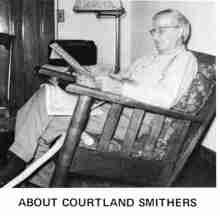
Mr. Smithers is credited with being
instrumental in starting the Poultry show, Cattle Shows, and was on the library
building committee with Bessie Rickett and Stanley McCadam. It was the Library
who had his book History of Heuvelton and Vicinity published. The book
was revised and updated by Persis Yates Boyesen, Oswegatchie and Heuvelton
Village Historian.
Heuvelton was Indian territory in the early
1800s for the Algonquin and Iroquois Indians. The St. Lawrence River was the
boundary between the two nations and these two nations were serious enemies.
From his book I learned that the only Indians who seemed to have made this area
a permanent home were a collection of families from Iroquois Nations and known
as the Oswegatchie. The area was little known to white men at that time.
According to the book, an early map of this section made for King George III
shows the Oswegatchie at or near the spot known as Eel Weir. Further, the first
missionaries from France to arrive here made a good impression on the Indians,
and when the white men arrived, the Indians were friendly to those who treated
them right and fairly. There were reportedly some ugly skirmishes when the
white men did not live up to the agreements which were made with the Indians.
Heuvelton was originally known as East Branch
and was considered an ideal location for a prosperous community because of its
natural rock bottom fording for crossing the River. The possibility of water
power development was also recognized, and today a Niagara Mohawk power plant
stands nearby, but is no longer in use. The first survey of the proposed town
had two streets - York and Lisbon. York extended from the fording place in the
river to the blazed trail leading to Ogdensburg while Lisbon was intended to
connect with settlements to the east.
In 1802 three log cabins were built near the
river to accommodate the men who were building the first log and pole bridge
across the river. Upon completion of the bridge the area was named Fordsburgh
(Nathan Ford).
In 1802 Jacob A. Vanden Heuvel purchased
18,000 acres in this area. Jacob was an aristocrat with little use for manual
labor and even less business experience. He did, however, have a bank account,
and an "enthusiastic desire to become rich and famous". Fordsburgh
became Heuvel shortly after his purchase of the land.
In 1829 Van Heuvel built the Episcopalian
church at the corner of State and Clinton streets. It is now owned by the
Catholic Diocese and is one of the oldest churches in the St. Lawrence River
Valley.
In 1832, Jacob had his name legally changed
from Vanden Heuvel to Van Heuvel, and in January of that year the village name
was changed to Heuvelton. The book states that the name change happened in the
"same" year, so apparently Heuvelton came into existence just prior
to Jacob's name change.
In
1834,Van Heuvel built a lavish home in Heuvelton, called the "Blue Mansion" which still stands today, where he
entertained lavishly and had many servants.
Return
to Top
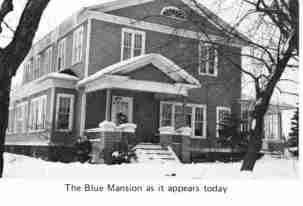
Another interesting tidbit of history I came
across recently was the Heuvelton Mechanics' Band. The picture below is from
1879. This seems particularly relevant to me at this time since we just had our
Labor Day Parade and community pride is running high at the moment. I have
purveyed this picture and information from Ted and
Beth's web pages at http://www.orednet.org/~bjohnsto/genealog.htm, with their permission.
Heuvelton (NY) Mechanics Band
- 1887
Return
to Top

L-R: __ Goodnugh, Robert Johnston, L. Simons, J. Bell, H.
Furnace,
Frank Johnston, W. Millard, __
Anderson, No Name, Homer Johnston,
Geo.
McFadden, W. Popple, C. Flack, F. Laning, Foster Johnston.
If you know who has the original of this
picture, or others like it, I and Ted and Beth's pages would like to hear from
you.
OK, so now we know approximately where
Heuvelton came from and that it had a band in 1887. This allows for a rather
smooth transition into the Heuvelton school system. I have legitimate school
records dating back to 1879, slightly before this picture was taken, and from
Courtland's book, I have gleaned a few more details about our school's
beginnings. The History of Heuvelton and Vicinity contains a wealth of
further information about Heuvelton's beginnings if you are inclined to read
it. I would start looking for it at the Heuvelton Free Library if you would
like purchase information. I do not recall where or when or where we acquired
the book, but it was my wife who found it.
Anyway, about the school:
First I'd like to say that my experience at
Heuvelton Central was terrific! I was actually a late-comer to the school,
arriving in the early part of the ninth grade. We had previously lived in
Ogdensburg, moving to the Heuvelton area shortly after my Father died. It was a
particularly difficult part of life for me and the acceptance and friendliness
of the school was a welcome change in my life. I formed many allegiances at
Heuvelton.
No records of the exact location of the
original school house (or someone's home?) can be found for the winter of 1808
- 1809, but the assumption made by Courtland is that it was the log cabin
occupied by the Remington family when they arrived from Vermont. Apparently the
only clue to locating a school building was a memorandum written by Nelson
White Howard, "who remembered attending school in a small frame building
located at or near the spot where the stone school was built" later. The
schoolhouse was reported to be near the present school site, with a pine grove
behind it. It was a wooden building and faced south, and there was a burial
ground on the west side of the lot. According to a quote from Nelson Howard,
"The inside arrangement of the house was peculiar; on it right, as you
entered the door, was a very large fireplace, about one third of the floor
space was level, then there was an incline upwards towards the North side of
the room. Several aisles with desks and seats was the method of seating the
pupils. There were no out-houses."
In
October of 1822, Vanden Heuvel deeded the site for a school building. A one
story stone house was constructed and served as the local school until 1874.
This stone school house appears to have been built sometime prior to 1837 and
was on the same site as the wooden school house. In 1852 the school house
burned. It was rebuilt and remained there until 1874 when a large two story
frame building knows as Union Free School of Heuvelton
was built. That building was razed in 1954 according to Courtland's
writings.
Return
to Top
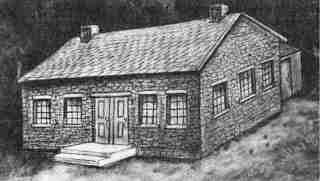
Old
Stone School House - Heuvelton N.Y. - 1824-1874
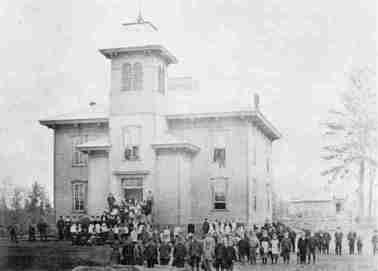
Union Free
School built in 1874
In 1948 the squeeze was on and the Union Free
School was just too small, and getting smaller by the day as the number of
students increased steadily. In that year the proposed centralized district was
laid out and established. The bond issue was finally passed in early 1952. The
school's first commencement exercises were held on June 22, 1953 with a class
of 20. The building erected in 1952 was designed to accommodate 510 students
and by September 1954 was serving 617. Further bond issues were made in 1956
and 1964 for additions to the school. And it has grown in many ways even since
then.
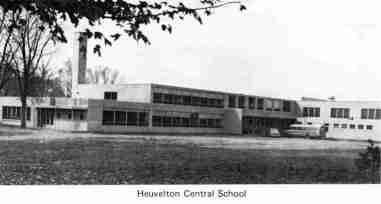
And so, kiddies, that concludes my history
lesson for now. There will be a test, so read carefully, please. The vast
majority of information in this page comes from History of Heuvelton and
Vicinity by Courtland F. Smithers. I wish I had known this wonderful man.